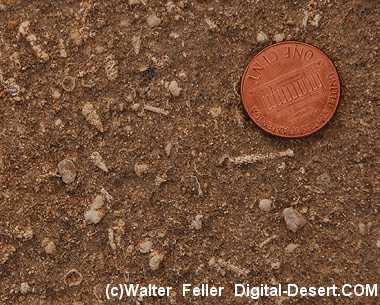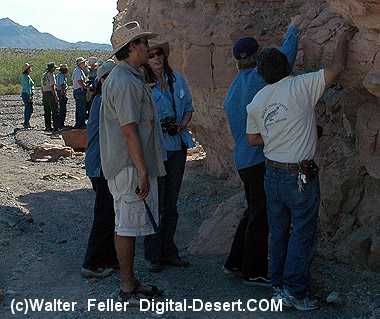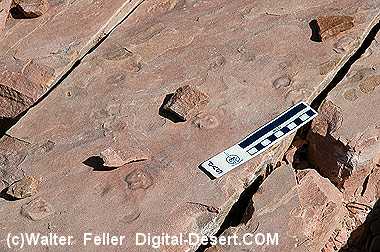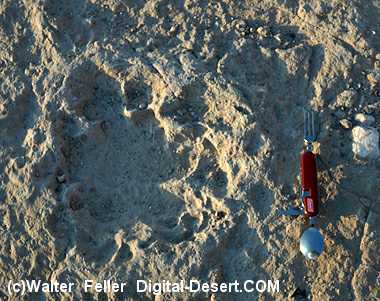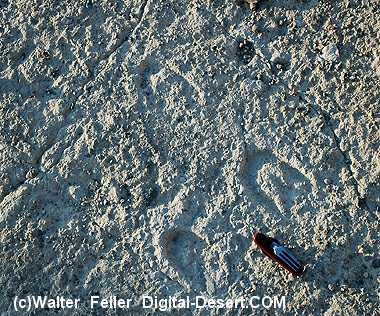Paleontology
Paleontology comes from the Greek word for ancient life.
Paleontology studies the remains of living things. The
Earth is dynamic and nothing remains the same for long.
The Earth has been changing for 4.6 billion years. Climates
change, rivers and glaciers altar course, seas rise
and fall. Animals and plants flourish and then die to make
room for new forms. The sediments that are laid down
change. To give order to these changes, the scientists
developed a scale that divides time into meaningful
periods. This time scale is called geologic time.
Fossils are a record of life as it has evolved through
geologic time. Fossils are invaluable to scientists in
reconstructing prehistoric environments. These life
forms have been buried in the earth, buried in the sea,
and captured in rock. They have been preserved in
peat, tar, ice, and amber. They may be unchanged from
the originals, or they may be a mineral replacement.
They range in size from dinosaur skeletons to tiny plants
and animals that can only be seen under a microscope.
Most fossils are formed from the hard parts of plants and
animals such as shells, bones, teeth, or wood. Eggs,
footprints and burrows can also be fossilized. The study
of fossils indicates that life originated on the earth 3
billion (3,000 million) years ago. Since that time there
has been a succession of plant and animal species.
Most are now extinct and only a few remain as fossils.
When one considers how quickly organisms are destroyed
after death it is remarkable that fossils are as
common as they are. Remains that can be destroyed by
scavengers, bacteria, chemical decay and erosion make
the odds against preservation extremely high.
Paleontologists are scientists who seek to understand
the succession of plants and animals through time. They
try to determine how these creatures lived, how they
grew and how they died. They try to answer questions
concerning the web of life, interactions between organisms,
and interactions between organisms and their
environment. Around the world, researchers are studying
thousands of sites, excavating fossils, and transporting
them back to laboratories where they are reconstructed.
The main clues for reconstruction come from
comparisons with living plants and animals. The rules
that govern how animals and plants cope with life are
presumably the same today as they have always been.
Some of the organisms that lived on earth left no descendants,
but many are still represented. These “living
fossils” can provide clues to the way long-dead organisms
looked and functioned.
The world of fossils is never static. Paleontology is
continually growing and evolving.
Paleontology and Geology
Geologic time is a measurement of the past. Without a
measurement tool, objects and events could not be
placed into proper relationships. The divisions of
geologic time are made on the basis of life that existed
at the time.
A geologic column indicates the types of rock that were
deposited.
The rocks of Kentucky were laid down in water. Soft
mud is often converted to shale. Loose sand and gravel
become converted to sandstone and conglomerates.
The third type of sedimentary rock is limestone, which is
precipitated from seawater. Limestone is also formed
from the shells of dead sea animals. Heat, pressure,
and chemical action may change these three kinds of
sedimentary rocks into a variety of metamorphic rocks.
The rocks of Kentucky belong to the Paleozoic Era. The
periods within this era are: Ordovician, Silurian, Devonian,
Mississippian, and Pennsylvanian. The Mammoth
Cave region of Kentucky was primarily a result of events
which occurred within the Mississippian period.
Geologic Time Frame Information
kya = thousands of years before present - Mya = millions of years before present
Cenozoic Era
Age of Mammals
Three Periods Broken into Eight Epochs
| Periods | Epochs | Time Frame |
| Quaternary | Anthropocene | Present -1950 CE |
| Holocene | 1950 CE - 11.784 kya | |
| Pleistocene | 11.784 kya - 2.588 Mya | |
| Neogene | Pliocene | 2.588 Mya - 5.333 Mya |
| Miocene | 5.333 Mya - 23.03 Mya | |
| Paleogene | Oligocene | 23.03 Mya - 33.9 Mya |
| Eocene | 33.9 Mya - 56.0 Mya | |
| Paleocene | 56.0 Mya - 66.0 Mya |
Earth's chronological dating
| # | Era | ||
| 1 | Cenozoic | 66 million years ago to 2017 | |
| 2 | Mesozoic | 252.17 to 66 million years ago | |
| 3 | Paleozoic | 541 to 252.17 million years ago | |
| 4 | Neoproterozoic | 1,000 to 541 million years ago | |
| 5 | Mesoproterozoic | 1,600 to 1,000 million years ago | |
| 6 | Paleoproterozoic | 2,500 to 1,600 million years ago | |
| 7 | Neoarchean | 2,800 to 2,500 million years ago | |
| 8 | Mesoarchean | 3,200 to 2,800 million years ago | |
| 9 | Paleoarchean | 3,600 to 3,200 million years ago | |
| 10 | Eoarchean | 4,000 to 3,600 million years ago | |
| 11 | Hadean Eon | Formation of Earth to 4,000 million years ago | |
http://digital-desert.com/paleontology/
Fossils, Rocks, and Time
By Lucy E. Edwards and John Pojeta, Jr.
Contents & Introduction
Putting Events in Order
The Relative Time Scale
Rocks and Layers
Fossils and Rocks
Fossil Succession
The Numeric Time Scale
Further Reading
